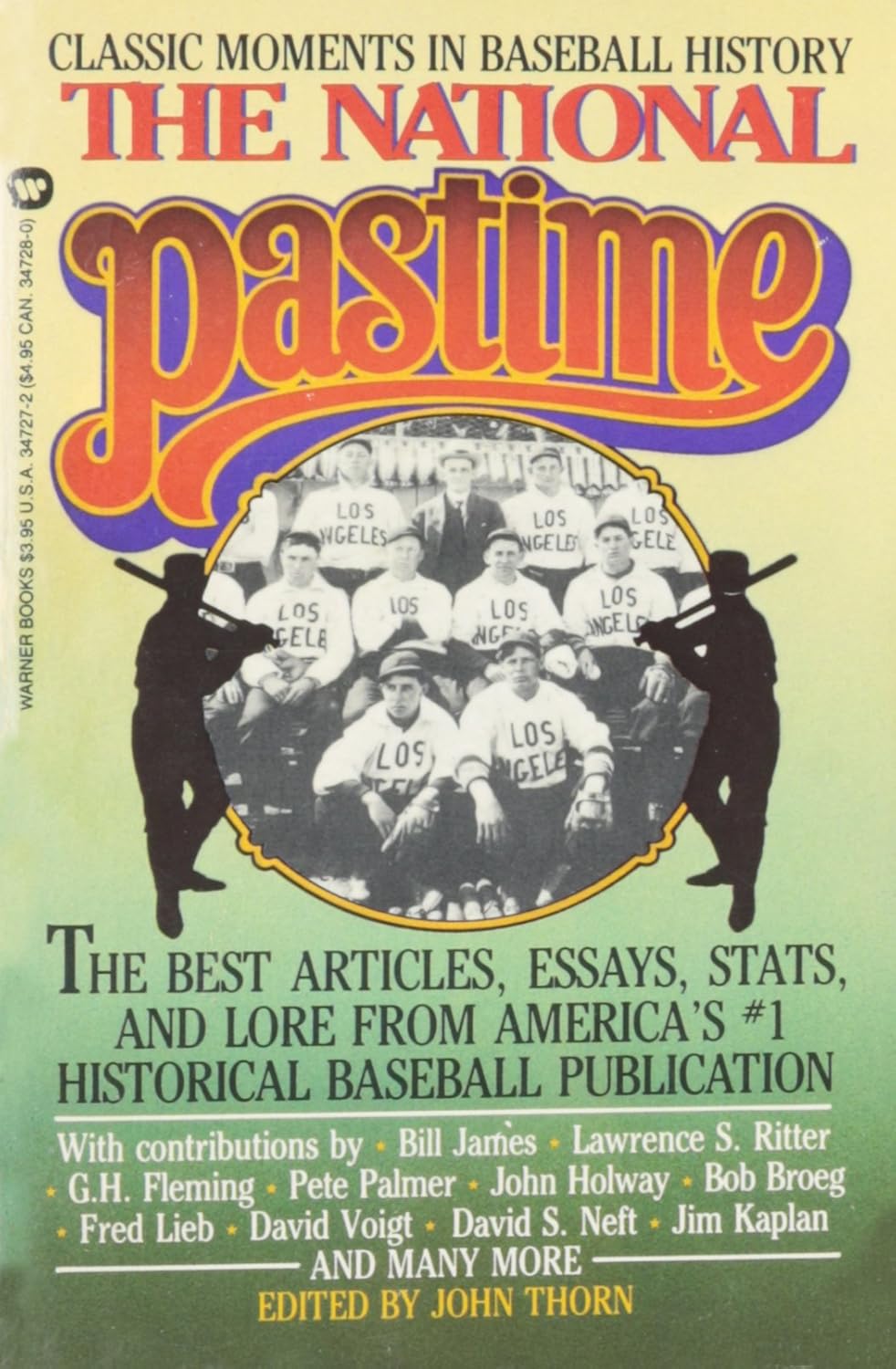Introduction: The National Pastime: Classic Moments in Baseball History
This article was written by John Thorn
This article was published in The National Pastime: Classic Moments in Baseball History (1987)
In 1987, SABR partnered with Warner Books to publish “The National Pastime: Classic Moments in Baseball History,” a collection of articles from the early years of SABR’s annual publications, the Baseball Research Journal and The National Pastime. It was reprinted the following year by Bell as a hardcover edition. All of the articles from the TNP anthology book can now be read online. Here is the introduction to the book.
 When Roger Clemens struck out 20 Seattle Mariners, he summoned from the cobwebs of 1884 the dimly remembered names of Charlie Sweeney and One Arm Daily, the pitchers who first set the record he broke. Pete Rose chased but failed to capture the ghost of Ty Cobb, much as Roger Maris and Henry Aaron did battle with the Babe. And the World Series Champion Red Sox of 1918 eerily prefigured the ill-starred crew of 1986: in 1918, the last time Boston won the Series, they did so in six games, winning the opener 1-0 behind southpaw Babe Ruth; that opening shutout was matched in 1986 by southpaw Bruce Hurst, whose name is an anagram for Ruth’s, and Hurst’s Red Sox came within one strike of winning in six games.
When Roger Clemens struck out 20 Seattle Mariners, he summoned from the cobwebs of 1884 the dimly remembered names of Charlie Sweeney and One Arm Daily, the pitchers who first set the record he broke. Pete Rose chased but failed to capture the ghost of Ty Cobb, much as Roger Maris and Henry Aaron did battle with the Babe. And the World Series Champion Red Sox of 1918 eerily prefigured the ill-starred crew of 1986: in 1918, the last time Boston won the Series, they did so in six games, winning the opener 1-0 behind southpaw Babe Ruth; that opening shutout was matched in 1986 by southpaw Bruce Hurst, whose name is an anagram for Ruth’s, and Hurst’s Red Sox came within one strike of winning in six games.
Baseball history lives. It is a seamless web in which every act on the field or off connects with a myriad of others, enriching the storehouse of legend that nurtures the game and the nation.
This collection of articles, essays, stats, and lore is dedicated to the proposition that baseball’s past is every bit as exciting as its present. That past is not merely what happened in 1886 or 1936—it is also the events of 1986; it is yesterday’s box scores perused this morning; it is today’s game, history aborning. In the eternal hot stove league of the mind, Branch Rickey and Rickey Henderson are soulmates, Christy Mathewson and Tom Seaver duel at checkers, and Fred Merkle wraps a consoling arm around Bill Buckner.
These flights of fantasy are hardly less fantastic than some of the game’s historical verities, such as the astrological keys to baseball success (no fooling: read John Holway’s “Diamond Stars”) or the weirdly kindred couple of Hack Wilson and Roger Maris (see Don Nelson’s “A Tale of Two Sluggers”). If the 1986 Cy Young Award winner in the National League, Mike Scott of the Astros, has had a fantastic season by winning 18 games, what adjective does Webster’s hold for the year when Hoss Radbourne won 60? (See the piece by Frederick Ivor-Campbell.) If great hitting is what turns you on, get a hold of this one from Bill Mead’s “The Year of the Hitter”: In 1983 Lonnie Smith, then with the Cardinals, missed the National League batting championship by a scant .002; if he had been warped back to 1930 with his .321 average, he would have found himself ranking seventh—not in the league, but on his own team.
History is not all that’s on display in these pages. There is analysis by such giants of sabermetrics—Bill James’ coinage for the mathematical and statistical study of baseball—as David Neft, Pete Palmer, and James himself. There is nostalgia (remember Harry Perkowski? Van Lingle Mungo?). There is opinion (let’s go back to eight-team leagues; today’s players are better than the old-timers; old-time ballparks were better than today’s). There are amusements (a ballparks quiz, an acrostic puzzle). And there is outstanding research underlying the whole volume.
When I developed The National Pastime for the Society for American Baseball Research (SABR) in 1982, the organization had been splendidly served for a decade by the Baseball Research Journal, created and edited by L. Robert Davids. It was Davids whose idea SABR was and whose untiring efforts made that idea take hold. A masterful researcher, he is represented in this volume with a piece on the youngest major leaguers, one of several articles reprinted from SABR’s original annual publication.
What is SABR, anyway? It is a group of over 6,000 people of diverse backgrounds, united by their love of baseball and their desire to know more about it. Some are active researchers who pursue their areas of interest through one or more of SABR’s committees, like minor leagues, or statistical analysis, or records, or biographical. Others simply like the SABR publications or the camaraderie of the regional and national meetings.
Who is a typical SABR member? The writers in this book, former ballplayers, club.and league officials, doctors and lawyers and butchers and bankers. And you are, too, or you wouldn’t be reading this; all that separates you from us is a membership. After you’ve read and enjoyed this book, as I’m sure you will, see the back pages for the lowdown on what is, to these admittedly biased eyes, baseball’s best bargain since the bleacher seat.
JOHN THORN has been a SABR member since 1981 and served as SABR’s first Publications Director.


